#winnipeg tribune
Text

The Winnipeg Tribune, Manitoba, November 11, 1933
6K notes
·
View notes
Note
halloween is a celtic festival, it was brought over to the americas by scottish & irish immigrants. you might be thinking of the phrase "trick-or-treat" which is definitely canadian?
@77bears You're absolutely right, it started in Celtic British cultures.
I was referencing the gif that called Halloween an "American holiday" but I probably should have made it more clear that I meant in the sense of "in the Americas".
But modern Halloween as a whole is, as far as we have evidence for, a Canadian invention. One of the earliest mentions of people dressing up and going door to door is in 1898 in Vancouver:

^ Vancouver Daily World (Vancouver, British Columbia, Canada) Wednesday, November 02, 1898, pg. 6.
though there are earlier mentions of Halloween in Canada dating to at least 1820.
By 1910 in Winnipeg, we have the first recorded evidence of Halloween being widespread, as Halloween candy buckets were being advertised:

^ The Winnipeg Tribune (Winnipeg, Manitoba, Canada) Tuesday, October 18, 1910, pg. 10.
Halloween pranks were first reported in an 1898 Vancouver newspaper article saying that Halloween pranks would not be a problem that year.
And, like you mentioned, "trick or treat" was first recorded in Canada -- in 1927 in Blackie, Alberta (only a few hours away from where I live!)
#halloween#happy halloween#canada#ask response#i'm just saying#world history#halloween history#did you know#random facts#alberta#united states#trick or treat#canadian history#holiday
26 notes
·
View notes
Text

“HUGE ILLICIT STILL SEIZED AT WEST ST. PAUL,” Winnipeg Tribune. December 29, 1932. Page 1.
----
TWO ARRESTED FOLLOWING RAID ON DAIRY FARM
---
Plant Has Capacity of Gallons of Alcohol Daily
----
Believed To Have Been Operating For One Year
---
Raid and Arrests Made by Mr. Stubbs of Federal Excise Department
----
One of the largest illicit distilling plants ever seen in Manitoba was seized by William Stubbs of the federal excise department and a squad of R. C. M. P. on Wednesday at Lot 121, W St. Paul, one mile west of McPhillips St., and 10 miles from the city limit. Charles Pichurski and his son Mike, in whose barn the plant was found, were arrested.
Both appeared in provincial police court today when Magistrate Welsford allowed them out on ball of $2,000 each.
The still has a capacity of 1,0000 gallons of mash and running at full capacity would produce gallons of alcohol each. At the time of the seizure there were found 3,000 gallons of mash in barrels and a very large quantity of alcohol. These will be destroyed.
Cleverly Concealed
Officer Stubbs says that, from appearance and from information he received since the arrests, it would appear that the huge still has been in operation for upwards of one year. During that time, many thousands of gallons of Illicit liquor must have been dispensed.
The ‘private distillery’ was cleverly concealed and hundreds of persons must have walked under it without being aware of its existence. It was situated in the hay loft of a large bam in which 20 head of milk cows were stabled.
The still room was separated from the hay loft in a room spotlessly clean and papered. The pipe from the boiler fire found its outlet through the barn ventilators in the roof while the steam exhaust went through the wall to a manure pile.
Deserves Great Credit
Great credit is due officials for the seizure. Although it was known very large quantities of liquor were being distributed from the part of the country for a long time no clue could be obtained regarding the point of origin.
Two days ago, however, there was a ‘leak’ and as a result suspicion was directed against Pichurski and his son. The farm premises were carefully inspected on three occasions before the still was discovered.
When the premises were raided, it is that the two arrested were preparing to go to work on the job of turning out a liquor shipment.
Besides the liquor and plant there was also seized during the raid a very large quantity of sugar and other materials for the manufacture of alcohol.
Such was the weight of the equipment and mash, that the floor of the hay loft was badly sagged.
Photo caption:
MONSTER ILLICIT STILL SEIZED
One of the largest illicit distilleries ever found in Manitoba was seized Wednesday by William Stubbs, of the federal excise department, and a squad of R.C.M.P. at West St. ten miles from the city. The arrests were made at the time of the seizure. The plant was found in a hay loft over a barn. It had a capacity of 1,000 gallons of mash and could produce 175 gallons of alcohol daily. Much liquor and equipment were also taken during the raid.
#winnipeg#illicit still#excise department#moonshining#moonshine#liquor control#rural crime#rural canada#farming in canada#royal canadian mounted police#police raid#great depression in canada#crime and punishment in canada#history of crime and punishment in canada
8 notes
·
View notes
Text

Mayor Stephen Juba in front of the partially demolished Gingerbread City Hall, April 27, 1962. Stephen Juba spearheaded the efforts to demolish the second city hall; the city had been trying to build a new one since 1913 (despite only managing to finally pay it off in the ‘40s). Juba would give tours to reporters, showing them how he could shake the rafters and pointing out the bones of a dead goat that had been on the roof for possibly thirty years that no one could get down because the roof was unsafe to climb out on. Photo taken by Winnipeg Tribune photographer Hugh Allen. Photo via the Winnipeg Archives
2 notes
·
View notes
Text
WSCM
WSCM 1: Winnipeg in 1920
The first room of a real and/or virtual Winnipeg School of Communication Museum has blowups of the following journal and newspaper reports:
Philosophical Review announcement of Wright and Lodge coming to UM
Henry Wright letter from 1920
Henry Wright profile in the Tribune
Rupert Lodge profile in the Tribune
There are pictures of Winnipeg at that time, particularly of the University of Manitoba downtown campus and a map showing the locations of the university buildings.
There is a picture of S.I. Hayakawa (identifying him as the future President of San Francisco State University and US Senator from California) and a blowup (potentially with sound) of his oral history recording at the University of California:
“I graduated from the University of Manitoba in 1926. (…) The University of Manitoba wasn’t much in those days (…) no building that we ever went to is part of the University of Manitoba now. In fact, all those buildings have probably been torn down. (…) It wasn’t really a campus at all. In the first place, many of the classes were held in what used to be law offices, but the lawyers had moved on to better sites, offices somewhere else. Some of the buildings we had at the University of Manitoba were — I don’t know if you call them quonset huts or something of that kind. They were temporary shelters, and the real building of the university with its own buildings didn’t happen until long after I left Winnipeg. (…) At that time, the University, having no buildings of its own, conducted its classes in abandoned law offices a block or two away from the provincial parliament buildings.”
WSCM 2: Gertrude Avenue connection
Map showing 507 Gertrude and 600 Gertrude
Blowups of Henderson’s City Directory for Winnipeg in 1924 showing the McLuhans at 507 Gertrude and the Allisons at 600 Gertrude
Blowup of Hayakawa oral history (with sound?): “I had two close friends, Gerard and Carlyle Allison, and they had a little sister, Mary Josephine. Well, when Father [moved back to Japan and] established his head offices in Osaka, and Mother and my sisters were taken along afterwards to stay with him, I moved in with the Allisons. (…) Have I told you about the Allisons? He was professor of English, William Talbot Allison. (…) Did you enjoy staying with this family, the Allisons? I enjoyed it so much I’m still in touch with them. Papa and Mama [Allison] are dead long ago, but their — they had three children, two boys and a girl. I just talked within the last couple of days to one of the boys, who is long, long retired and quite ill. We’re still in touch [in 1988, over 60 years later!]. And the daughter, I was also on the phone with her a few days ago. How long did you live with them? About two years. Your nickname was Hak, then? Yes.”
Blowup of pages from In Thought and Action: The Enigmatic Life of S. I. Hayakawa: “In 1924, Ichiro Hayakawa [S.I. Hayakawa’s father] decided to relocate his firm’s main operation [from Canada] to Japan (…) Hayakawa’s two sons [Sam and Fred] remained in Canada, not only because it was their choice but because both parents recognized that Samuel [nicknamed ‘Hak’] and Fred weren’t culturally Japanese. (…) Hak, meanwhile, moved in with the family of one of his professors at the University of Manitoba, William Talbot Allison (…) Allison’s sons (…) had been two of Hak’s closest (…) friends (…) Another of his chums was the neighborhood paperboy, a youngster named Marshall McLuhan, whose path would cross Hayakawa’s several times in the decades to follow.”
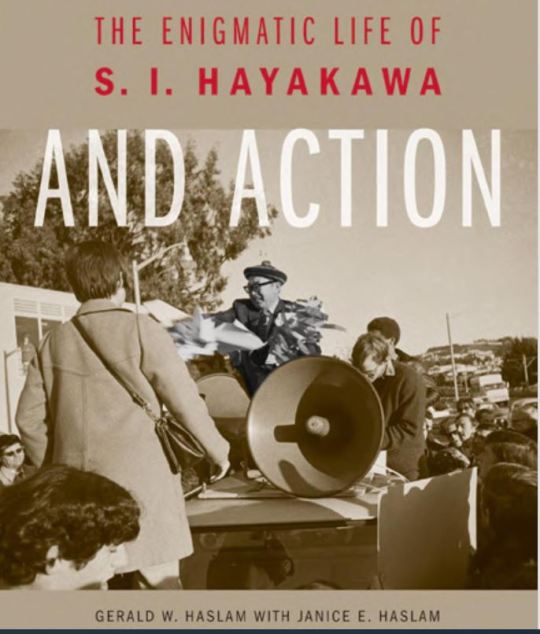
Blowup of a Trib page from 1927 showing McLuhan as a paperboy. McLuhan is in the picture on the right, back left:
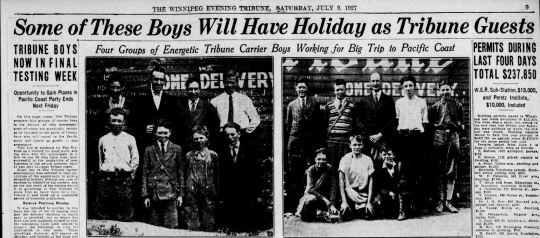
Blowup of a letter from Hayakawa to McLuhan in 1968, 40 years later:
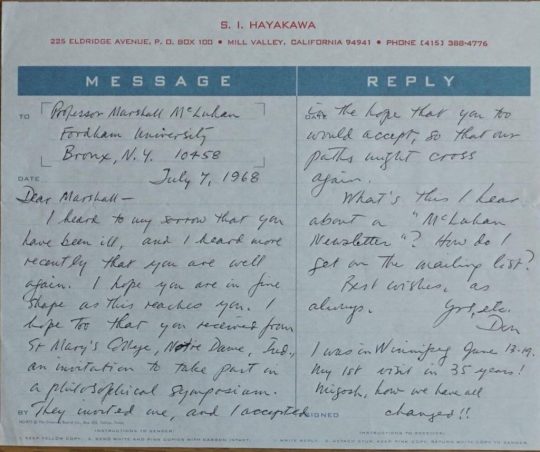
July 7, 1968
Dear Marshall —
I heard to my sorrow that you have been ill, and I heard more recently that you are well again. I hope you have received an invitation from St Mary’s College, Notre Dame, Ind., to take part in a philosophical symposium. They wanted me, and I accepted in the hope that you too would accept so that our paths might cross again.
What’s this I hear about a McLuhan Newsletter? How do I get on the mailing list?
Best wishes, as always.
Yrs etc, Don [Hak’s later nickname]
I was in Winnipeg June 13-19. My 1st visit in 35 years! My gosh, how we have all changed!
WSCM 3: Carl Williams & Kelvin
McLuhan and Carlton Williams were in the same year at Kelvin Technical High School in the mid 1920s. Displays include:
KTHS yearbook cover for 1927-1928
Pages from the yearbook of McLuhan’s and Williams’ classes with student pictures
The two then attended the University of Manitoba together.
Pages from the University of Manitoba yearbook with graduation pictures of McLuhan and Williams
In the 1950s McLuhan and Williams were University of Toronto professors, McLuhan in English and Williams in Psychology. They were two of the 5 faculty group leading the Culture and Communication seminar between 1953 and 1955.
Blowup of Explorations journal page listing the seminar’s 5 faculty leaders
It was Williams who instigated the notion of ‘auditory space’ (McLuhan’s ‘acoustic space’) in a seminar session in 1954:
Blowup of journal page showing Williams’ article on ‘Auditory Space’ in Explorations 4
Blowup of the blog post McLuhan & Williams on discovering ‘auditory space’
Williams became part of the University of Toronto administration and then President of the University of Western Ontario ( now Western University). His biography from the Western website:
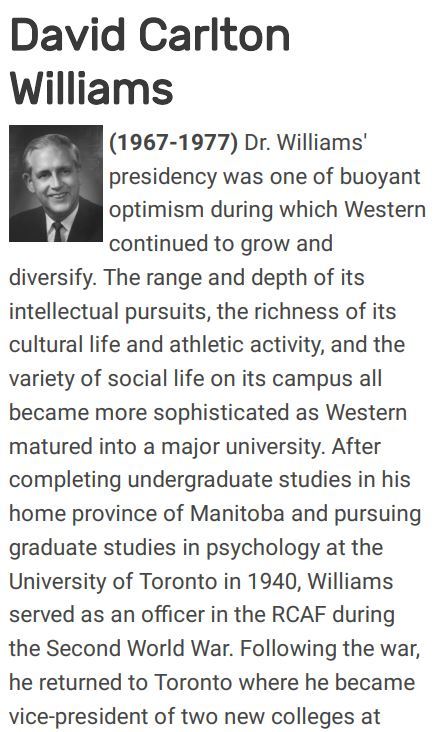
McLuhan and Williams remained close friends until McLuhan’s death at the end of 1980. Williams’ obituary of McLuhan is included in the memorial volume Who Was Marshall McLuhan:

Audio from Williams’ oral history recollections is featured throughout
WSCM 4: Tom Easterbrook
McLuhan graduated from Kelvin in 1928:
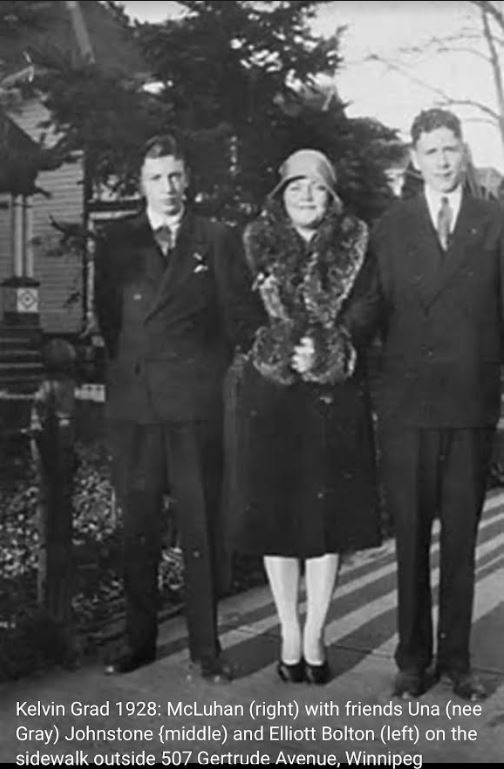
He then entered the University of Manitoba School of Engineering, later reporting that he was looking for a way to support himself while he went about his real work of research and writing. But the deeper reason for his choice of Engineering may have been his need to extricate himself from his father’s impractical lyricism and his mother’s literary caricatures. However that may have been, McLuhan’s one year in Engineering brought him a lifelong friend in Tom Easterbrook.1
Tom and I both started off [university] in Engineering [in the fall of 1928] and because of our long periods of study during the summer, we were able to upgrade ourselves into Arts. I read myself out of Engineering by my long summer [of 1929].
This was McLuhan in 1970, forty years later, in Speaking of Winnipeg:
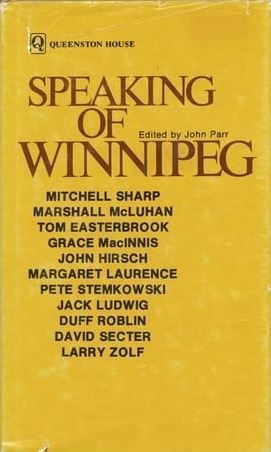
Again in Speaking of Winnipeg, the two described the argumentative rambles they took at the time:
We had an absolute agreement between ourselves to disagree about everything and this kept up (…) a very hot dialogue from morning to night for years in Winnipeg which carried us on foot across town at night, late at night till three or four in the morning, back and forth across the city.
The McLuhans lived south of the Assiniboine River in Winnipeg, the Easterbrooks north.
It was during their UM days, apparently in 1931, that McLuhan came to read G.K Chesterton through Easterbrook. This provided one of the initial steps towards McLuhan’s conversion in 1937 and became the subject of his first academic paper in 1936: ‘G.K. Chesterton: A Practical Mystic‘:
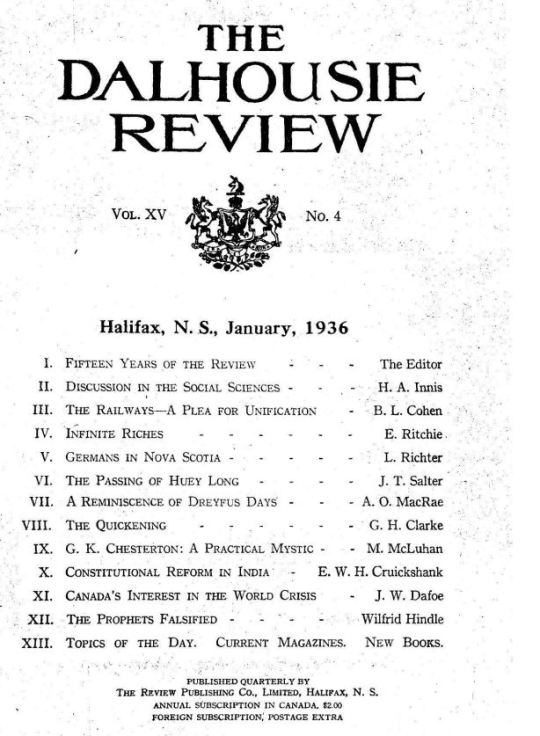
Another contributor to the issue was Harold Innis — when the issue appeared Innis was Easterbrook’s adviser at Toronto and increasingly his good friend.
In 1932 McLuhan and Easterbrook toured England together, working their way across the Atlantic on a cattle boat. This mode of transportation seems to have been popular option for young Winnipigeons at the time, doubtless due to Winnipeg’s role as the collection point for rail shipments between eastern and western Canada. Five years earlier Hayakawa got to Montreal in the same way. As recounted in his oral history:
Soon after graduating with my B.A. from the University of Manitoba, Gerard, Professor Allison’s oldest son, and I decided to take a cattle train to Montreal for a summer adventure. I cannot reconstruct how or where we had our meals on that train or where we slept. The reason we were getting a free ride across the continent is that, in the event of a train derailment or wreck, the cattle would start running away and the railroad wanted a few extra men on the train to help recapture them. We really had nothing to do — no duties — except in the event of a train wreck and escaping cattle.
After their UM degrees, McLuhan and Easterbrook continued their studies, McLuhan at Cambridge and Easterbrook at the University of Toronto. That Easterbrook’s advisor was Harold Innis decisively impacted McLuhan’s career when Easterbrook brought Innis and McLuhan together in 1948. Meanwhile, McLuhan in Cambridge and Easterbrook in Toronto remained in close contact through McLuhan’s mother and brother, who had moved from Winnipeg to Toronto and knew Easterbrook well through Marshall in Winnipeg.2
The Innis connection via Easterbrook would prove essential to McLuhan’s later work. For it was Innis who brought McLuhan to concentrate, not on ideas as he had in his PhD thesis on the educational trivium, but on the embodied ideas of technology. He came to see how human beings live in their ideas through technology — beginning with language.
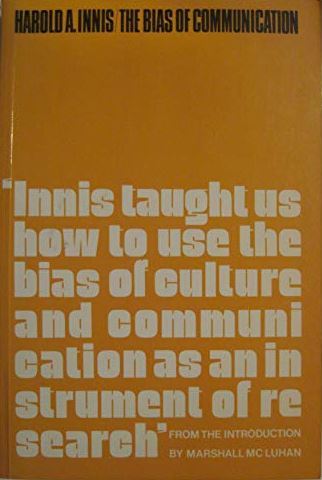
In the 1950s Easterbrook was one of the 5 professors leading the Culture and Communication seminar — three of them from Winnipeg (McLuhan, Easterbrook and Carl Williams) with their trilateral relationship going back a quarter of a century. McLuhan’s career as a communications guru may have started as a lark between them.
Perhaps incidentally, McLuhan offered this description of the prairie meadowlark in his conversation with Easterbrook in Speaking of Winnipeg:
We might as well have a few words about the superiority of the prairie meadowlark to all other songbirds (…) it has a much longer and almost melodic phrase. It isn’t a mere chirp; it has a melody. It talks to you. Besides it is extremely musical. It’s not just the solid glug-glug of the nightingale [championed by uninformed ornithologists like John Keats]. By comparison with the birds I’ve heard in Europe and England, it is enormously superior.
Like his friend and mentor, Harold Innis, Easterbrook went on to became chairman of the Political Economy department in Toronto. In 1960 he and McLuhan lectured together at the annual meeting of the Economic History Association. Innis had been one of its founders in 1940 and its second president in 1942.
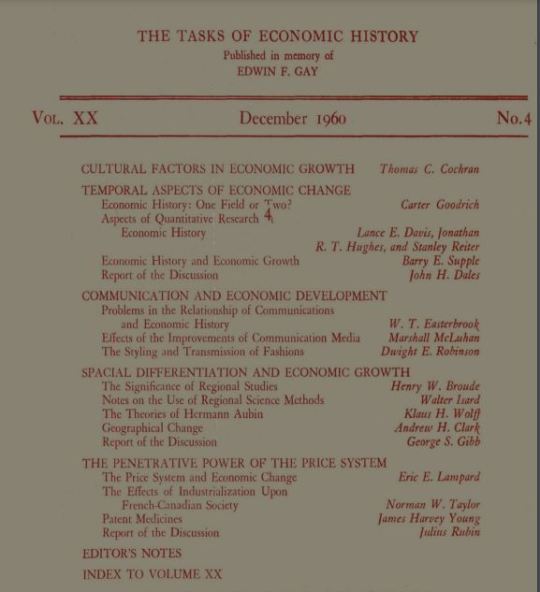
After McLuhan’s death at the end of 1980, Easterbrook expressed his regret that their relationship had been so argumentative. But their gapped complementarity on everything doubtless benefited them both in multiple ways and served as the cement in their half century friendship.
In his oral history Easterbrook recalled that they actually met the next year, 1930, after both had quit engineering for Economics (Easterbrook) and English (McLuhan).
Elsie and Maurice McLuhan left Winnipeg for Toronto at the same time that Easterbrook did. He began grad studies at UT in the fall of 1933 and Elsie and Maurice decamped in September that year.
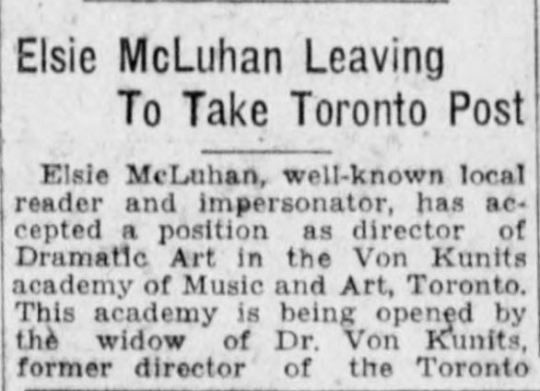
Elsie announced her departure with this press release. It appeared in the Winnipeg Evening Tribune for September 9, 1933, p4.
WSCM5: Watson Kirkconnell
Watson Kirkconnell (1895-1977), a professor of English and Classics in Winnipeg, was a family friend of the McLuhans who is mentioned repeatedly in the Cambridge correspondence between McLuhan and his mother. McLuhan would have known him growing up in the 1920s. Later, Kirkconnell and McLuhan became correspondents themselves. Kirkconnell sent an offprint of his article ‘Icelandic-Canadian Poetry’ from the 1934 Dalhousie Review to McLuhan in Cambridge:
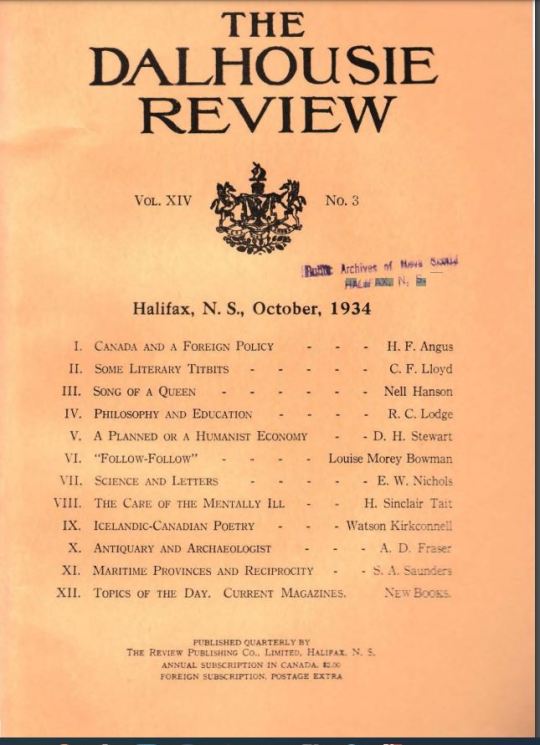
Published in the same issue was Rupert Lodge’s ‘Philosophy and Education‘, a paper on which McLuhan worked with Lodge (as Kirkconnell may well have known) — an essay providing a threefold theory of education that McLuhan would flesh out with a 2000 year history of the trivium in his PhD thesis a decade later.
At the Manitoba Historical Society website, Kirkconnell’s entry among ‘Memorable Manitobans‘ describes him as follows (click to enlarge):

He was Professor of English at Wesley College in Winnipeg from 1922 to 1930 and head of the classics department there from 1930 to 1940. He then led the federal government’s “Nationalities Branch” (which became the Citizenship Bureau) during the Second World War. He also headed the Humanities Research Council in 1943 and the Baptist Federation of Canada in 1944.
After a period at McMaster University [immediately after the war], he was President of Acadia University from 1948 to 1964. He wrote 40 books, 130 brochures, and 600 articles, as well as innumerable translations from some of the 50 languages with which he was familiar. He was particularly important in translating Ukrainian and Icelandic poets into English.
A NYT article from August 20, 2022, reported on ‘Canada’s Growing Linguistic Diversity‘. But a full century before this, Kirkconnell, at Wesley College (later United College and ultimately the University of Winnipeg) was already investigating and celebrating this mosaic.
Following his presidency of the Humanities Research Council of Canada, he remained an influential figure in the organization, authoring its 1947 history and contemporary overview, The Humanities in Canada, with A.S.P. Woodhouse, chair of the UT English department. Between 1937 and 1965 Kirkconnell contributed an annual review ‘Publications in Other Languages’ to the University of Toronto Quarterly.
The Kirkconnell room at the WSCM includes blowups of many of his books along with photos of him. Correspondence between Kirkconnell and McLuhan from the Kirkconnell papers at Acadia (some of which is cited in Gordon’s Escape into Understanding bio) and from the McLuhan letters at York is featured. The University of Manitoba also has some Kirkconnell materials.
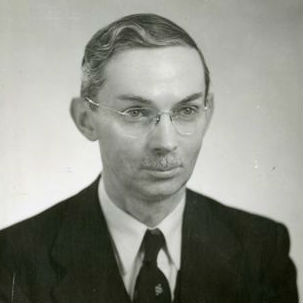
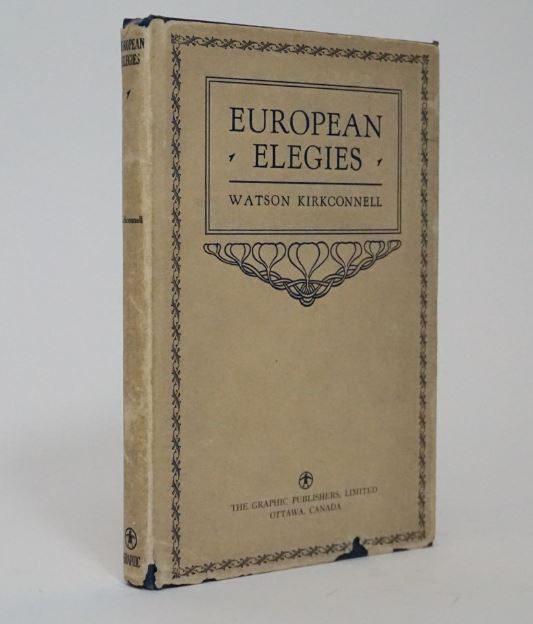
One Hundred Poems Chosen and Translated from European Literatures in Fifty Languages. Watson Kirkconnell, 1928.

Canadian Overtones: An anthology of Canadian poetry written originally in Icelandic, Swedish, Norwegian, Hungarian, Italian, Greek, and Ukrainian, and now translated and edited with biographical, historical, critical, and bibliographical notes by Watson Kirkconnell. Published in Winnipeg in 1935.
WSCM6: Reading Wright
Sometime soon after McLuhan transferred from Engineering to Honours English in 1929, in 1930-31 perhaps, he took the UM introductory philosophy course which was given in two halves, one taught by Rupert Lodge, and the other by Henry Wright. Presumably Lodge concentrated on Plato and Wright on modern authors.
One of the books studied in Wright’s part of the course was his own 1925 volume, The Moral Standards of Democracy:
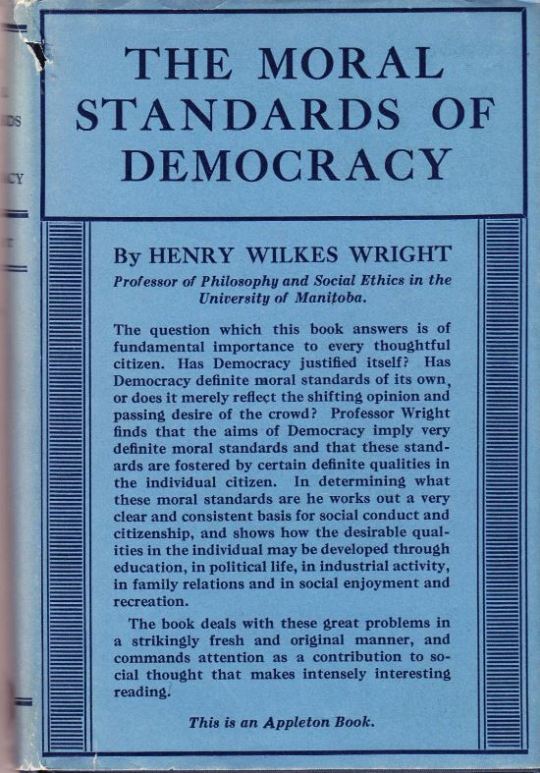
McLuhan’s “heavily annotated” copy of Moral Standards remains in his library which the McLuhan family has donated to the rare book collection at Fisher Library of the University of Toronto.

The museum will feature blowups of pages from Wright’s book and of McLuhan’s notes in it.
Here is Wright on pages 86-87 of Moral Standards (all emphasis added):
In modern society, association by direct personal contact has been supplemented and, so far as social organization is concerned, has been largely replaced by impersonal association and indirect contact. Now these activities of indirect contact and communication proceed through the intermediation and instrumentality of mechanical agencies. And these agencies themselves are extensions in the physical world of those bodily organs of inter-communication and personal association (…) possessed by every human being; namely, those of oral and written speech, of practical contrivance and construction, and of aesthetic perception and artistic creation. Hence these three activities of intercommunication (…) are fundamental in the double sense of determining both the direct personal association of human individuals with one another, and also the indirect association of millions of individuals as fellow citizens and fellow workers. (…) Moreover such chance as there is of giving personal value to indirect and impersonal contacts brought about by modern large scale social organization, and thereby making it a MEANS for realizing that comprehensive social community for which democracy stands, depends altogether upon our understanding this social machinery as an extension into the physical world of the three activities of personal intercommunication: [1] discussion [“oral and written speech“], and [2] cooperation [“of practical contrivance and construction”], and [3] imaginative sympathy [“aesthetic perception and artistic creation“].
Here is Wright again in 1937 in ‘Mechanism and Mind in Present-Day Social Life’, which he contributed to Manitoba Essays: Written in Commemoration of the Sixtieth Anniversary of the University of Manitoba (ed Rupert Lodge):
Machine technology and the mechanical instruments it has devised for facilitating the outward activities and inter-play of human individuals on a large scale have had the effect of externalizing the interests and activities of man to such a degree that his inner, personal life is becoming impoverished and his spiritual faculties atrophied through disuse.
The enormous enlargement which radio and film have given to the scope and range and diversity of sensory stimulation is too obvious to need illustration. The same may be said of the effect of automobile, aeroplane, machine tools, electrical appliances, etc., upon man’s powers of outward action and motor performance. But no such adventitious aids have been supplied by the arts of technological invention to the inner interpretative processes of rational reflection and creative imagination. Thus, in a generation preoccupied with new ranges of sight and hearing, and fascinated by a variety of new mechanical tools and toys, these inner activities have for the time at least been relegated to the background and allowed to wither from neglect.
No more urgent or pressing problem confronts modern society than [the question] of the influence of mechanism and mechanical intermediaries upon the character and relations of men.
What measures it is practically wise to adopt, however, will depend upon the relation of mechanism and mechanical instrumentalities to the nature of man.
The characteristic activity of the human organism is not mechanical, topographical, and aggregative, but is rather dynamical, configurational and organismic.
The question [must be posed] of the influence on present-day social life and personal development of the newly invented machinery of social interaction and inter-communication.
The question [must further be posed] of how the technological instruments which in their great and amazing variety dominate our civilization and differentiate it from every previous stage of human history are related to human nature and the personal associations of men.
These technological instruments which have revolutionized the social life of man, from telephone and radio to automobile and aeroplane, from electrical household appliances to automatic machinery for (…) manufacture of economic goods and the reproduction of art products, are extensions through physical forces and mechanical intermediaries of man’s bodily organs.
Consider in the first place all mechanical devices for the transmission of fact and opinion: telegraph and telephone and radio, the newspaper and colour-press, billboard, illuminated sign, and news-reel. These are all of them MEANS of increasing through physical intermediaries the range both in space and time, and the social influence, of man’s powers of articulate speech, oral and written.
These are one and all mechanical MEANS for making available for popular appreciation and enjoyment on a practically unlimited scale the products of man’s powers of emotional expression and aesthetic perception. Now if this is a fact, and I do not see how it can be denied, there follow from it consequences of genuine, far-reaching social importance. The products of modern science and invention are not correctly understood as belonging to another, alien world, a world of matter and mechanism, forever separate and divorced by essential nature from that other inner realm in which alone are realized the distinctively human and truly personal values, such as truth, practical goodness and beauty, the “imponderables” of the spirit. On the contrary, they, like the organic agencies whose power and range they enormously augment, are in veritable fact projections of human personality itself and [the potential] MEANS of satisfying the distinctively personal interests of man.
These mechanical instruments and devices which dominate the modern social scene (…) are veritable extensions of the powers of human personality and effective [potential] MEANS for the co-operative realization of the most comprehensive and enduring values of personal and social life.
McLuhan’s entire intellectual life might well be understood as the extended interrogation of Wright’s observations:
“the inner interpretative processes” — how are these to be specified? what field encompasses them? how does this field of Wright’s “inner realm”1 feed back into its own investigation? if all specification falls within the field, how begin it without already having begun it? how get out of the endless circularity that seems to be implied here? the maelstrom…
our “inner, personal life is becoming impoverished and [our] spiritual faculties atrophied” — since humans can never not exercise their “inner interpretative processes”, their “spiritual faculties”, how could these “processes” ever become “impoverished” and “atrophied”? how is this even a possibility for humans? what does such a possibility imply about the complex nature of human being?2
and how does this possibility feed back into the investigation of such questions? could investigation itself become “impoverished”? is the “Waste Land” first of all a matter of our “inner interpretative processes”?
“the influence of mechanism and mechanical intermediaries” — can investigation into media (“understanding media”) prove to be an Ariadne’s thread for the labyrinth of these questions?
McLuhan’s later “interior landscape”.
Wright suggests that there are different “fundamental” possibilities that originally structure human experience: “The characteristic activity of the human organism is not mechanical, topographical, and aggregative, but is rather dynamical, configurational and organismic.” What does ‘characteristic’ mean here? How does an individual or society ‘switch’ between these modes? What sort of time or times is implicated here?
WSCM anteroom: peace in the global village?
The anteroom of the WSCM has only two displays. The first is a large poster (or posters) with a description of the museum:
The Winnipeg School of Communication has local importance recalling now forgotten chapters of Winnipeg’s twentieth century history:
The downtown University of Manitoba campus
The outstanding people who taught at UM in those days and their outstanding pupils like S.I. Hayakawa , Marshall McLuhan, Tom Easterbrook and Carlton Williams.
Hayakawa (later the President of San Francisco State University and US Senator for California) and McLuhan were neighbours in the 1920s in Fort Rouge and remained in intermittent touch for the next half century. McLuhan and Easterbrook (later chairman of the Political Economy Department at the University of Toronto) were University of Manitoba classmates who toured England together in 1932. Williams (later President of the University of Western Ontario) was in the same year as McLuhan at Kelvin and the two continued at UM together. The personal and professional relationship of McLuhan, Easterbrook and Williams lasted the rest of their lives. And they were 3 of the 5 professors — McLuhan in English, Easterbrook in Political Economy and Williams in Psychology — who led the Culture and Communication seminar at the University of Toronto in the 1950s. It was this seminar and its Explorations journal which provided the springboard for McLuhan’s renowned communications work in 1960s and ’70s.
This museum tells the multimedia story of these people, of their importance to communications theory and of their multiple interactions with one another.
But is the Winnipeg School of Communication of only local and historical interest?
McLuhan famously foresaw a world of generalized warfare, universal spying, cultural breakdown, and the hijacking of entire nations — a world in which human survival comes into question. Ominously, he was not mistaken. The global dystopia he predicted 70 years ago is increasingly upon us today.
At the same time, however, McLuhan attempted to describe an exit strategy, a ‘strategy for survival’. And it is here that the international — not local — and contemporary — not past — interest of the Winnipeg School is to be located. What is the possibility of peace in the global village under nuclear conditions?
Seeds of an investigation of that question were planted in Winnipeg over 100 years ago. But its implementation has hardly started to this day, despite all the work of the Winnipeg School. Hence its development remains an urgent matter for the future — if we are to have a future.
Another poster cites McLuhan’s first mention of the ‘global village’ from a speech given in Winnipeg in 1959:
Another aspect of the (…) instantaneous flow of information from every part of a situation, from every quarter, is that we develop a new attitude to space, a new attitude to time. The globe becomes a very small village-like affair, under electronic conditions, in which whatever happens to anybody, happens to everybody; and living in this very small new space, as it were, causes us paradoxically to take very long views, in the matter of time. (‘New Business Rules In Our Electronic Age’, a speech before the Winnipeg Ad and Sales Club, May 11, 1959)
0 notes
Text
Ottawa's $40B First Nations child welfare deal upended by Canadian Human Rights Tribunal | CBC News
A key part of a $40 billion dollar First Nations child welfare agreement described as "historic" by the federal government could unravel following a ruling Tuesday by the Canadian Human Rights Tribunal.
The tribunal rejected Ottawa's $20 billion offer to compensate First Nations children and families harmed by the discriminatory on-reserve child welfare system.
It said the deal did not meet its criteria because it left some children out and did not guarantee the $40,000 in compensation for each child and caregiver ordered by the human rights body in a landmark ruling.
"The Tribunal never envisioned dis-entitling the victims who have already been recognized before the Tribunal through evidence-based findings in previous rulings," the decision said.
The tribunal said the federal government's cap of $20 billion for compensation would leave out some victims covered by the ruling.
The tribunal said First Nations children removed from their homes and placed in non-federally funded placements are excluded from the final settlement agreement, along with the estates of deceased caregiving parents and grandparents.
It also said that some parents and grandparents would get less than the $40,000 it ordered, along with some children and caregivers denied essential services under a policy known as Jordan's Principle.
The tribunal also took issue with the short time frame for victims to opt out of the final settlement agreement.
Under the agreement, claimants have until February 2023 to opt out of compensation and litigate on their own. If they don't, they won't be able to take their own legal action.
"Such an opt-out scheme would place victims who are receiving less than their CHRT (Canadian Human Rights Tribunal) entitlement of $40,000 in an untenable situation whereby they either accept reduced entitlements under the FSA [final settlement agreement] or opt-out of the FSA to be left to litigate against Canada from scratch," the decision said.
The federal government announced in January it had reached a $40 billion agreement with the Assembly of First Nations (AFN) to settle two class action lawsuits. The government said it met the terms of the human rights tribunal's ruling.
The agreement set aside $20 billion for individual compensation and $20 billion for long-term reform of the on-reserve child welfare system.
Now, the federal government's plan to complete the $40 billion deal by the end of the year could be derailed unless it can address the tribunal's concerns.
At a press conference in Winnipeg on Thursday, the AFN's lead negotiator said she was "deeply frustrated."
"It's a sad day for the many First Nations families learning today that their long wait for compensation and acknowledgement is going to continue," said AFN Manitoba Regional Chief Cindy Woodhouse.
"I don't know when or if compensation will flow to these kids and families at this stage."
Indigenous Services Minister Patty Hajdu said the government wants to make the $40 billion agreement work.
"It is disappointing to many First Nations people that a First Nations-led, Indigenous-designed approach hasn't been accepted as complete by the CHRT," Hajdu said.
"There's a continued commitment to First Nations to make sure that we satisfy both aspects of these historic agreements."
NDP MP Charlie Angus said the federal government must comply with the tribunal's orders.
"This government must respect their obligation to pay compensation to the children who have been put at risk through the wilful and deliberate negligence of this government," Angus said.
The agreement needed the approval of the Canadian Human Rights Tribunal, which ruled Ottawa's on-reserve child-welfare system and its health care delivery discriminated against First Nations children. The tribunal ordered $40,000 in compensation to affected children and caregivers.
The federal government lost a challenge of the tribunal's order before the Federal Court and paused a subsequent appeal pending the approval of a settlement agreement.
It covers children and families on-reserve or in the Yukon who were discriminated against from 1991 on — a period 15 years longer than the one covered by the tribunal's orders.
Under the agreement, every First Nations child who was forcibly removed from their home and put into the on-reserve child welfare system would get a minimum of $40,000 — or more, depending on the severity of the harm they experienced.
Cindy Blackstock, executive director of the Caring Society, asked the tribunal to send the deal back to the negotiating table because it short-changed compensation for some and gave nothing at all to others covered by the tribunal's ruling.
She told CBC News that nothing in the tribunal's ruling stops the government from continuing its $20 billion overhaul of the on-reserve child welfare system.
"We support the final settlement agreement, but we don't want any kid or any family member who was hurt so badly by Canada left behind," Blackstock said.
"It might cost Canada more … But what Canadians need to know [is] that's only there because Canada hurt so many children."
Blackstock, who was not part of the compensation negotiations between the AFN and Ottawa, said the agreement leaves out children who were not in federally funded child welfare placements.
But the federal government and the AFN disagreed and argued that only children placed in federally funded placements are eligible for compensation under the tribunal's orders.
In 2016, the tribunal found Ottawa discriminated against First Nations children and said Canada's actions led to "trauma and harm to the highest."
In 2019, the tribunal ordered Canada to pay the maximum penalty under the Canadian Human Rights Act — $40,000 to each First Nations child and caregiver affected by the on-reserve foster care system and their parents or grandparents, as long as the children weren't taken into care because of abuse.
It also ordered Canada to pay $40,000 to each child and caregiver denied essential services under a policy known as Jordan's Principle.
Instead of paying compensation in the way the orders are worded, the government negotiated a deal with the Assembly of First Nations, which was suing Ottawa for $10 billion to compensate for a group of children and families not covered by the tribunal's orders.
In January 2022, the AFN and the federal government announced a $40 billion settlement agreement to cover the cost of settling a Canadian Human Rights Tribunal order, two class action lawsuits and long-term reform of the Indigenous child welfare system over five years.
1 note
·
View note
Text
Un sacerdote jubilado de 92 años acusado en relación con una acusación de abuso sexual en una escuela residencial en Manitoba se declaró inocente.
El padre retirado Arthur Masse de Winnipeg fue arrestado en su casa en junio y acusado de un cargo de agresión indecente. El cargo se deriva de una investigación de la RCMP de 11 años sobre acusaciones de abuso sexual en la antigua Escuela Residencial Fort Alexander entre 1968 y 1970.
RCMP dijo anteriormente que la investigación se inició después de que la policía recibió un aviso sobre el presunto abuso en febrero de 2010, y alegó que el incidente involucró a una niña de 10 años que estudiaba en la escuela.
Ninguna de las acusaciones ha sido probada en la corte y se presume que Masse es inocente. Fue puesto en libertad con condiciones.
El caso del sacerdote jubilado volvió a la sala del tribunal el miércoles en Powerview, Man. Aunque Masse no hizo una aparición física, su abogado, George Green, confirmó a CTV News que Masse se declaró inocente del cargo.
Afuera del salón de la legión, donde estaba ubicada la sala del tribunal, un grupo de líderes de las Primeras Naciones y miembros de la comunidad salieron a apoyar a las víctimas y sobrevivientes.
Entre ellos estaba Victoria McIntosh, de 63 años, quien se identificó como la víctima del caso.
“A muchos de nosotros nos mantuvieron en la oscuridad sobre el legado de las escuelas residenciales y ver a mis compañeros sobrevivientes, realmente me da mucho consuelo”, dijo, y agregó que planea seguir el caso “en cada paso del camino”. '
El próximo caso judicial de Masse se trasladará a Winnipeg, con la próxima fecha programada para el 14 de septiembre.
El jefe Derrick Henderson, jefe de la Primera Nación Sagkeeng, donde se encuentra la escuela residencial Fort Alexander, también se encontraba entre los que se reunieron fuera del salón el miércoles. Dijo que First Nation está brindando apoyo comunitario a McIntosh y otros sobrevivientes.
Dijo que la Primera Nación planea proporcionar algo de transporte desde Sagkeeng a Winnipeg, un viaje de casi una hora y media, para seguir el caso judicial.
“Este es un gran caso que involucra a los tribunales y a la iglesia y debemos asegurarnos de que se haga justicia para nuestra gente”, dijo Henderson.
Manitoba RCMP ha confirmado previamente que esta es la única investigación sobre las escuelas residenciales en las que están involucrados, y no anticipa que se presenten más cargos.
Si usted es un ex estudiante de una escuela residencial en apuros, o ha sido afectado por el sistema de la escuela residencial y necesita ayuda, puede comunicarse con la línea de crisis de las escuelas residenciales indias las 24 horas: 1-866-925-4419
Recursos y apoyo de salud mental adicionales para pueblos indígenas están disponibles aquí.
Con archivos de The Canadian Press
0 notes
Photo
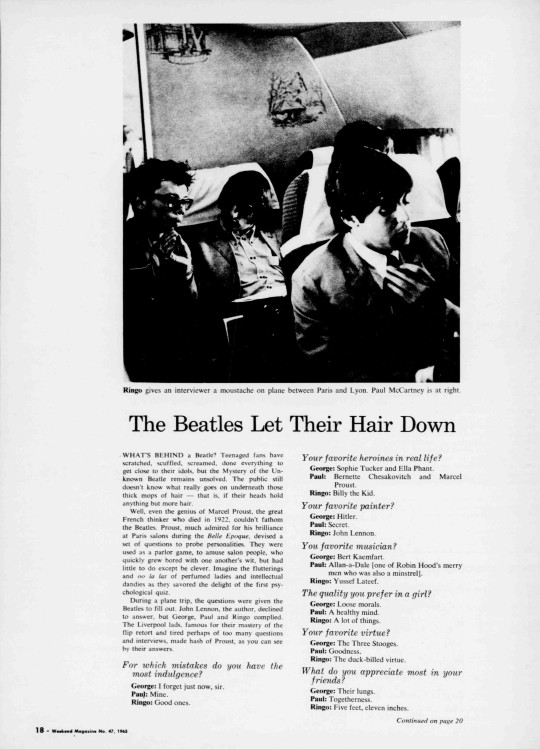
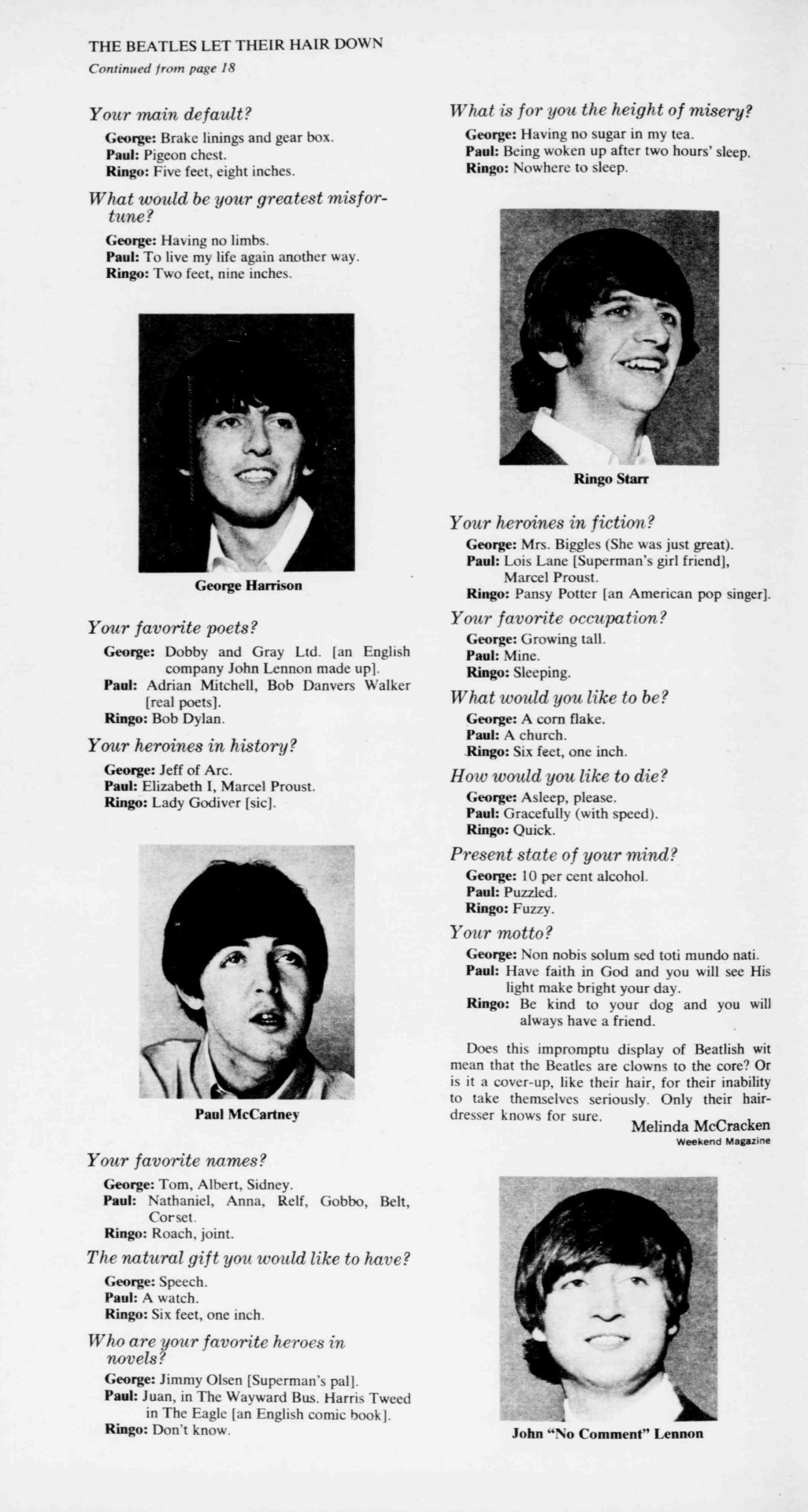
The Beatles Let Their Hair Down (article in the Winnipeg Tribune weekend magazine, November 1965)
#winnipeg tribune#canadian newspaper#1965#john was like nah#the beatles#john lennon#paul mccartney#george harrison#ringo starr#sixties#1960s#1960s music#magazine article#magazine photos#old magazines#own post
297 notes
·
View notes
Photo

Gustav Sebald (on the right) photographed by the reporter from The Winnipeg Tribune, Daily Punctilio’s rival newspaper. [ courtesy of Sally Sebald ]
#gustav sebald#asoue#sebald productions#vfd#vfd aesthetic#asoue aesthetic#vintage#vintage photography#winnipeg tribune#newspaper#reporter#40s#?#or#50s#vfd style#vfd vibes#lemony snicket#sally sebald#Daily Punctilio#volunteer fire department#a series of unfortunate events#sugar bowl generation#sugar bowl gen
78 notes
·
View notes
Photo
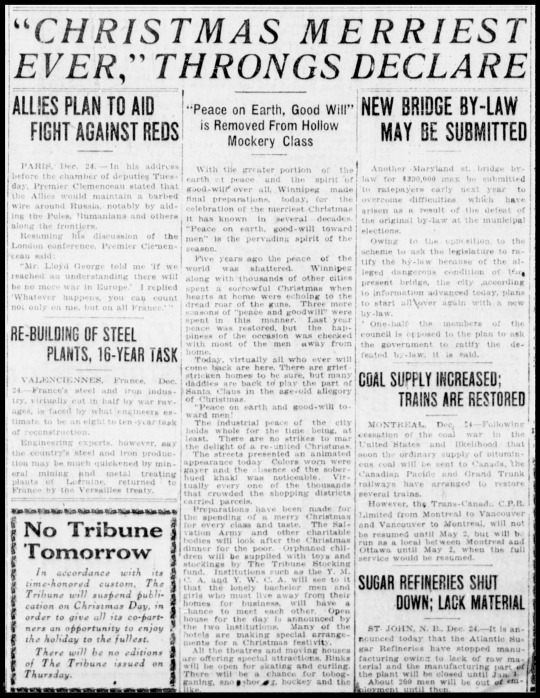
24 December 1919 - The “Merriest” Christmas
In their 1919 Christmas Eve issue the Winnipeg Tribune declared the upcomig Christmas holiday to be the “merriest ever”.
“With the greater portion of the earth at peace and in the spirit of good-will over all, Winnipeg made final preparations, today, for the celebration of the merriest Christmas it has known in several decades.”
Just thirteen months since the armistice was signed, putting an end to the fighting, Canada was still recovering from the First World War. 1919 marked the first Christmas since the start of the war where "virtually all” the men who served had returned home. The Tribune also gave a nod to the 1919 general strike, reminding readers “the industrial peace of the city holds whole for the time being, at least. There are no strikes to mar the delight of a re-united Christmas”.
Holiday festivities were organized by the YMCA, YWCA, and local hotels; theatres were open, “offering special attractions”; curling and skating rinks were open for public use; and outdoor activities like “tobogganing, snowshoeing, [and] hockey” were encouraged
3 notes
·
View notes
Link
“Lillian says she talked to Louis B. Mayer about it once, too.
“’It IS a great story,’ he said, and then he thanked me for startling him. He said he was a small town exhibitor when The Birth of a Nation was released. He knew the picture was a hit. So he pawned his wife wedding ring and mortgaged an insurance policy to buy the picture for his theatre. The film made him a small fortune.”
1 note
·
View note
Text
The Death of Julia Johnson

Spring on the prairies often suddenly and with little warning. The weather becomes warm, snow melts quickly, the days are much longer than remembered. But winter usually does not let go of her grip until it is almost summer. And on a typical spring day, 25th April 1928, five-year-old Julia Johnson disappeared.
Julia Johnson was the daughter of immigrant parents living at 138 Austin Street in Winnipeg. She was described as a pretty and shy girl who rarely ventured far from home. That day, Julia was playing with a tennis ball near her home while waiting for a friend to come home from school. According to the Winnipeg Free Press, Mrs. Johnson had spoken to her daughter and that a neighbour, Mrs. Pauline Kral, who was close to the Johnsons and mother of Julia’s friend, Elizabeth, had seen Julia playing just before she vanished. Mrs. Kral said that she told Julia not to go anywhere, and that Julia replied, “No I won’t. I’m just playing here.”
Five minutes later, Mrs. Johnson went to check on Julia, only to find that the little girl was gone.
Julia was last seen wearing a red and black dress, black shoes, fawn-coloured stockings, and a brown hat. She was about forty pounds, had blue eyes, and dark brown hair.

Location of 138 Austin Street
The police searched the neighbourhood that afternoon and interviewed locals. Boy scouts, school children, and neighbours joined in the search, looking in parks, allies, and sewers. Authorities brought in trained sniffer dogs to search around the Johnson home, but turned up nothing.
The police noted that behind the Johnson home was the Green River Building, at 187 Sutherland Avenue. The building was vacant, and the lot between it and the Johnson’s was rented by a blacksmith, called Nathan Taplinsky, to store wagons used for hauling scrap metal. His smithy was at 190 Sutherland Avenue. Taplinsky was questioned, as he was known to chase children off his wagons so they would not hurt themselves. Taplinsky stated to police that he had last seen Julia with some other children in the lot at about 2:00 PM as he was leaving for home.
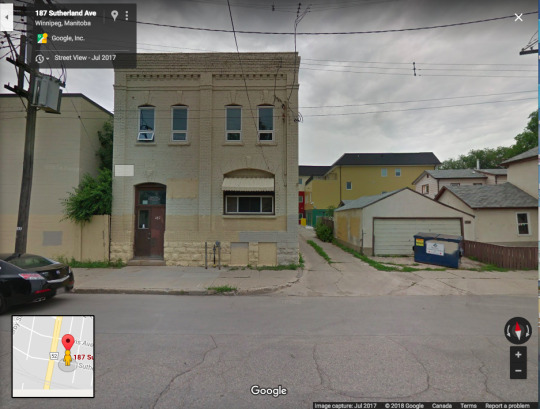
Location of 187 Sutherland Avenue
Between 3:00 and 3:30 PM, Julia was seen playing with her ball across from her home. This was about the time that the Mrs. Johnson and a Mrs. A. J. Newmark spoke to Julia and saw her for the last time. At 3:50 PM, Mrs. Kral was at her home at 136 Austin Street when she last saw Julia. Five minutes later, Mrs. Kral’s son, Alfred, came home and asked if she had seen Julia, as Mrs. Johnson was looking for her. Mrs. Johnson was much distraught by Julia’s absence, as she was very shy and would not wander off on her own. Mrs. Johnson would contact the police at 4:30 PM, and Constable McKim would be the initial responding officer.
Due to its proximity, and Taplinsky’s wagons being a popular hang out spot, McKim and John Johnson, Julia’s brother, went to the Green River building. However, they found it locked and secured and searched no further. After nightfall, the search was called off, though police continued to patrol the neighbourhood for the rest of the night.
The following day, as Julia was not being found, the thought of foul play crossed the officers’ minds and the Detective Division was called in. Inspector R. R. MacDonald took charge of the case. The detectives were at a severe disadvantage. If Julia had been abducted, then no commotion had been made. Unless it was someone she knew. Furthermore, there had only been five minutes between the last time Mrs. Johnson had seen her daughter, and when she realized Julia was missing.
A door to door search commenced and all neighbours were questioned. Several noted seeing a middle aged man in the neighbourhood the day Julia went missing. They described him as anywhere between 45-65, wearing dark clothing, unshaven and possibly being Eastern European in appearance. The witnesses were taken to the Rupert Street police station and asked to point the man out from a photo lineup. All the men the witnesses picked out were already in custody and were promptly eliminated from their suspect pool.
The Johnsons were devastated by Julia’s disappearance, and while they did not have much money, they put up a $50 reward ($741 CND in 2017), which was increased to $2,000 (nearly $30,000 in 2017) with donations from the Winnipeg Free Press, Winnipeg Tribune, and the Winnipeg Police commission. The publicity of the case and the reward money brought in tips from as far afield as British Columbia and Santa Monica. Many of the tips were sadly useless. Many spiritualists and mediums claimed to have made contact with Julia, but lead to nothing.
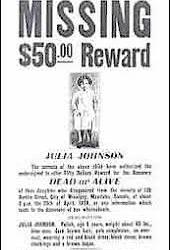
Mrs. Johnson did cope well with her daughter’s disappearance, having “taken to her bed” while Mr. Johnson kept searching.
Legitimate tips did produce leads for the police. One tip pointed to a neighbour with a lengthy criminal record. When police went to question him, he refused to talk. The police were eventually forced to let him go as they had nothing on him. In 1929, the man faked drowning in the Red River and ran away to Seattle, Washington. He eventually got into trouble with the Seattle police, was arrested, and when questioned, the man mentioned that he was in trouble in Winnipeg. The man was promptly deported to Canada and after reaching Winnipeg, was questioned by police. However, the man continued to refuse to talk about Julia and the police had to let him go. This was apparently the last time Winnipeg police had contact with him.

The police would continue searching for Julia. In 1929, Police searched a massive area of Winnipeg. Every empty building was searched, including the Green River Building behind Julia’s home.
A machinist named Wilfred Adams was hired by Muzeen and Blythe Machinists to start working on the Green River building to get it back in working order. Adams was to dismantle a large boiler in the basement. On 22nd March 1937, Adams would make a gruesome discovery. At 2:00 PM, Adams cut open the combustion chamber of the boiler and found the mummified remains of a young girl. A hat and tennis ball lay in the boiler with the tiny body.
It was Julia Johnson.
Julia was fully clothed. She laid in a U-shape so that the head and feet were almost touching. One shoe was off her foot. The ulna and radius bones were separated at one elbow. X-rays showed that Julia had a fractured pelvis, but no other wounds. There was no sign of strangulation when examined. Julia’s body was sent to the University of Manitoba to be examined by Dr. Daniel Nicholson of the Pathology Department. Test conducted on her clothing for blood or sperm only found blood on one of her stockings.
The case was re-opened. The first task was to determine who had access to the Green River building. The last owner had been the N. P. Beverage Company owned by Walter Hamilton. The business had closed down and the building vacated on 7th April 1928. Hamilton was tracked down and stated that there were two keys to the building and both had been given to John Godwin of the Montreal Trust Company, who was the rental manager of the building.
Godwin, by this time, was living in Toronto. He remembered Julia’s disappearance and said that he had gone to the building and checked that it was locked up and secure. Godwin stated that he had then gone to Nathan Taplinsky, had given him a key, and arranged to have Taplinsky check on the building meters and to let in prospective tenets to view the building. According to Godwin, and with business partner, Abraham Bulstein, as a witness, Taplinsky had told Godwin to hang the keys on a nail in the door post. Godwin said that he had used the key several times and had always put it back on the nail. He remembered that the key should have been with Taplinsky when Julia went missing.
Police located a William Clark, a Winnipeg Hydro Meter reader from 1928, who stated that he had obtained the key to the Green River building from Abraham Bulstein at the blacksmith shop. After Clark had finished his inspection, he had put the key back.
Unfortunately, Inspector MacDonald, head of the initial investigation, had passed away in 1936. It was therefore impossible to know how the police had gained access to the building or if the boiler had been checked in 1928.
On 8th April 1937, detectives brought in Taplinsky and Bulstein for questioning. Taplinsky stated, just as he did in 1928, that he had seen Julia playing with other children around his wagons at about 2:00 PM. He chased them off, and that was the last time he saw her. Taplinsky denied that the Green River building key had ever left his shop that day. When pressed, Taplinsky became nervous and started to cry, but maintained that the key never left his shop. Bulstein denied seeing Julia that day and affirmed Taplinsky’s statement that the key had never left the shop.
While the investigation continued, an inquest was held regarding the evidence. The jury concluded that “… from the evidence submitted, we the jury find that the deceased, Julia Johnson’s death was from causes unknown, and we are entirely dissatisfied
with the conflicting evidence submitted by GODWIN (Rental Mgr.), CLARK (Meter Reader), TAPLINKSY and BULSTEIN (Blacksmiths).”
The investigation ground to a halt. No new evidence would turn up. No new suspects were questioned. Nothing. The Julia Johnson case has remained unsolved for 90 years, and will likely go down as Winnipeg’s own Babes in the Wood case. It is still unknown if Julia was murdered, or if she had suffered a tragic accident. It is unknown what happened to the neighbour who faked his death and fled Winnipeg just after Julia’s disappearance. Did he have anything to do with her? How did Julia end up in the boiler? From the position of the body, she must have been placed there. Was Julia snatched, or was she lured away?
But what is important to remember is that a family suffered a tragedy. The loss of a young child must have ripped a hole through Johnsons. Their only consolation was finding the body and laying her to rest.
Five minutes can change everything.
Sources:
http://www.winnipeg.ca/police/history/story5.stm
http://historicnews.blogspot.ca/2011/08/julia-johnson-mystery-winnipeg-1928.html
http://kidnappingmurderandmayhem.blogspot.ca/2012/03/little-julia-johnson-unsolved-murder-in.html
#julia johnson#julia johnson case#true crime#canadian true crime#canadian history#winnipeg#manitoba#manitoba true crime#manitoba history#winnipeg history#tw child death#tw death#winnipeg free press#winnipeg tribune
2 notes
·
View notes
Text

"BURNING OF JEWISH BOOKS IS PROTESTED," Winnipeg Tribune. May 11, 1933. Page 2.
----
Close of 1,200 Attend Meeting of Protest Against Nazi Activities
---
The civilized nations of the world. should protest the burning of Jewish books in Germany, declared Rabbi Osher Zilberstein at a protest meeting against the recent Nazi actions held in the Hebrew Free school Wednesday night.
A large audience, numbering close to 1,200, attended the meeting to hear Rabbi Zilberstein, Dr. I. Pearlman, Marcus Hyman, and several other speakers. Ald. M. A. Gray was in the chair.
Rabbi Zilberstein said the protest of the world should say. "Give up your powder and guns, you modern barbarians; such things are a danger, even in the hands of civilized people, much more so in yours; put on bow and arrow and turn back to your woods." He characterized the burning of the books as a "horrible exhibition" and an "insane practice."
The modern mediaevals of Germany burned the records of physics, mathematics, medical science, music and art, only because they were of Jewish authorship. Such things could only be condemned and pitied. Hitler had tried for 14 years to show that the Jews were responsible for Germany's troubles, and later for the world's, but now he was demonstrating that they were responsible only insofar as Einstein's Theory of Relativity, Freud's Psychoanalysis and Heine's poems were.
Dr. Pearlman stated that that not only were the Hitlerites destroying the best that had been created in their world of literature, but an integral part of German culture."They may destroy the books, but they will never succeed in destroying the spirit contained in them," declared S. Miller, another speaker.
#winnipeg#mass meeting#antifascism#jewish canadians#resistance to antisemitism#antinazism#nazi seizure of power#hebrew free school#working class solidarity#jewish folk in canada#fascism in canada#great depression in canada#protest meeting
9 notes
·
View notes
Text
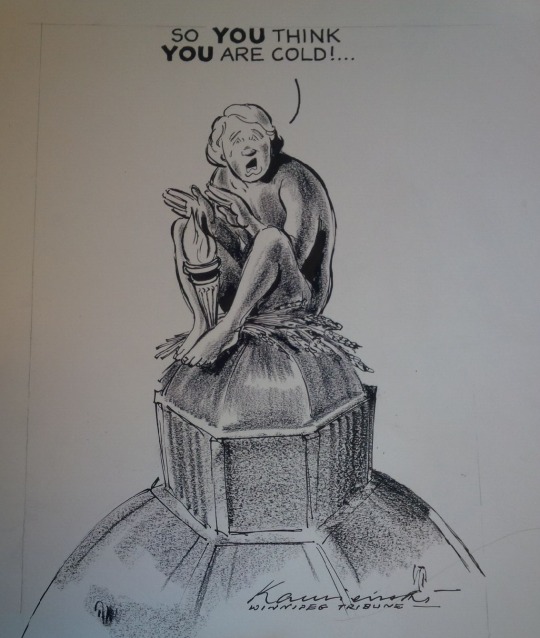
Cartoon drawn by Jan Kamienski and published in the Winnipeg Tribune newspaper, 22 January, 1966.
2 notes
·
View notes
Photo
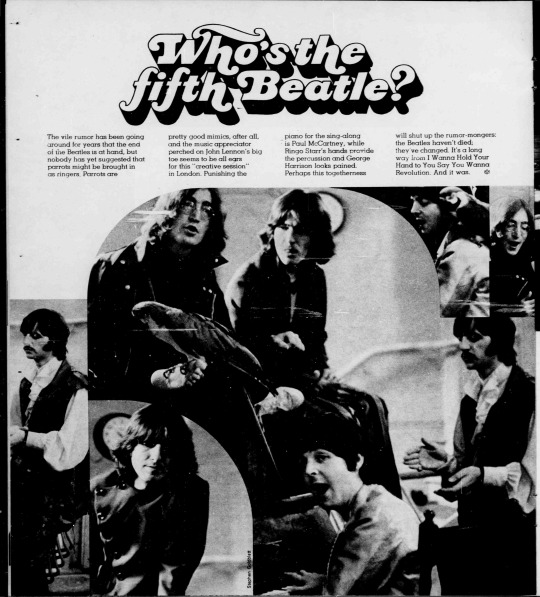
Who’s the fifth Beatle? (The Winnipeg Tribune, November 1968)
#the beatles#paul mccartney#john lennon#george harrison#ringo starr#the winnipeg tribune#newspaper article#newspaper photo#1968#own post
43 notes
·
View notes
Text
EDIT: OKAY WE GOT PICS OF ALL 10 ADS WOO
This list came from this post thanks to @genuinemusic and @daisiesonafield-blog , and especially @theirloveisgross for adding the newspapers and other location specifics. Most of this is a copy-paste of their work and you can find it here. I just wanted to document the ad appearing in the newspapers and link more to locations. Because they're absolutely newspaper headquarters:
Vase
29.4279, -98.4849, - San Antonio, TX (San Antonio Express News)
40.7748, -73.4108, - Melville, NY (Newsday)
40.7691, -111.9029, - Salt Lake City, UT (The Salt Lake Tribune)
49.9317, -97.1876, - Winnipeg, Canada (Canstar News, redirects to winnipegfreepress)
53.5418, -2.14973, - Oldham, UK (Manchester Evening News HQ)
55.8632, -4.2791, - Glasgow, UK (Sunday Mail)
52.5258, -1.8348, - Birmingham, UK (Solihull Mail)
-37.82071, 144.9666, - Southbank, Australia (The Sun Herald Melbourne)
59.327, 18.0152, - Stockholm, Sweden (Espressen)
25.674, -100.309, - Monterrey, Mexico (El Norte)
Ads already found in these papers, via twitter:
1. San Antonio, TX (San Antonio Express News), March 6

2 Melville, NY, Newsday (2), March 6

3. Salt Lake City, UT (close newspaper: The Salt Lake Tribune)

4. Winnipeg, Canada, thanks to @genuinemusic 's post, March 7

5 Oldham, UK, Manchester, close to [coords vs headquarters] Manchester Evening News, which seems to be where an ad was seen, original article published online March 4

6 Glasgow, UK (Sunday Mail), March 6

7 Birmingham, UK (Solihull Mail), March 7

8. Southbank, Australia (Herald Sun Melbourne)

9 Stockholm, Sweden (Expressen), March 6
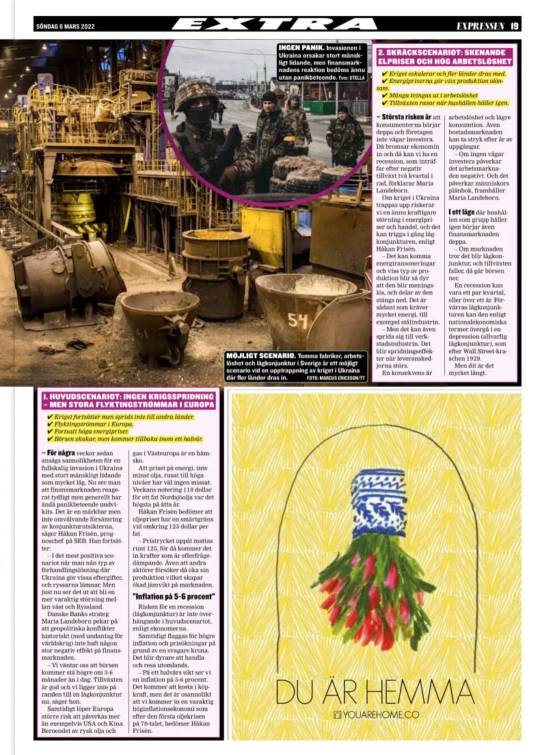
10 Monterrey, Mexico, El Norte

And for later:
Lamp
39.7647, -86.1583, - Indianapolis, IN (Indianapolis Star)
35.2203, -80.8441, - Charlotte, NC (Charlotte Business Journal)
49.9614, -112.5298, - Turin, AB, Canada (middle of nowhere. Literally not even a town. There's a Canada Post.. structure down the road)
53.7933, -1.5598, - Leeds, UK (Yorkshire Post)
-16.9222, 145.7781, - Cairns City, Australia (The Cairns Post, The Australian Newspaper)
-26.1855, 28.0293, - Johannesburg, South Africa (maybe Daily Sun in Media Park?)
44.8435, -0.5638, - Bordeaux, France (Sud Ouest newspaper)
-32.9460, -60.6379, - Rosario, Argentina (La Capital newspaper and others, also close to the Princess Park bar)
785 notes
·
View notes